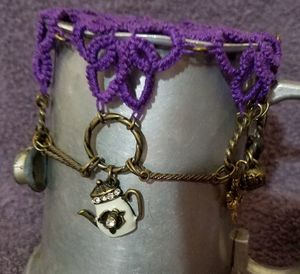When the Unicorn Came to Tea
When the Unicorn Came to Tea was a dual entry for the Bardic and the Arts & Sciences competitions at Altavia Anniversary and Investiture 2018, 5/12/2021.
The poem (bardic) was inspired by a cup cover (A&S) I created, which was inspired by a charm set I received as a gift. Below is the poem, the documentation for the poem, and the cup cover information.
When the Unicorn Came to Tea, A Poem Written By Me
When the Unicorn came to tea,
Quite a good deal of fun had we!
Have a cake, said he;
Take two, said me.
So, of course, we both had three!
There were cakes & cookies galore,
And sugar cubes by the score!
The tea was hot,
And we drank a lot.
And then we called for more.
The Hatter was certainly mad.
But the best tea server we had.
With pinky toe raised,
In a mercury haze,
His aim was not too bad!
The Hare came over to see
Whose unbirthday it was to be.
He’s on the March,
His comments quite arch.
And he completetly ignored his tea.
The Dormouse came out to play.
It happens most every day.
Go hide and seek,
We just won't seek,
He’ll sleep in the creamer all day.
What on the desk do I see?
A Raven it seems to be.
Poe wrote on both;
And he did quoth:
That this poem was written by me!
Cup Cover

The tea set charms on the cup cover were a gift from a friend and are responsible for this A&S entry. In trying to decide what to do with them, I realized there needed to be a unicorn. And the first verse of my poem grew in my brain.
I found a chain that went well with the charms, but no idea how to bring it all together.
Meanwhile the poem continued to grow, and when the six limericks were finished, I knew I had my template for my charm set.
I realized the chain and charms would make great edging for a cup cover, and decided to needle tat the cover.
The cup cover serves as a personification of the poem and the poem explains the cup cover … either that or I am just plain crazy!
(I heard what you said … and you’re probably right, it’s probably both!)
Poem Documentation
The Unicorn Came to Tea in a 6 limerick poem. A limerick is a five line poem in which the 1st, 2nd, and 5th lines rhyme and have 3 beats each, and the 3rd and 4th lines rhyme and each have 2 beats.
Some folks cite an 11th century manuscript as having the first written limerick meter poem. While others point out that Willie Shakespeare stuck a few in some in his wacky plays (“Othello”, “King Lear”, and “The Tempest.”). (1)
A good rule of thumb in SCA documentation is: if you can find it in Shakespeare or the bible then it's period ... So we're good there
You might think that this limerick poem reminds you of a something that happened to a young girl in 1865, but that is after our time period so it’s probably just a coincidence! In addition Poe wrote on The Raven, and the desk, in 1845 so we will talk about that Nevermore!
The Hunt of the Unicorn Tapestries (aka The Unicorn Tapestries) were woven between 1495 and 1505 and provide us proof that both unicorns and rabbits existed in period.
We can do even better with ravens ... they are included in the Poetic Edda (2), (compiled in the 13th century from earlier traditional sources) as the BFFs (Best Feathered Friends) of dear old Odin! Viking poems are as golden as Shakespeare and the bible for documentation!!
The dormouse has been in Europe from the Early Eocene Epoch (54.8 million to 49 million years ago) (3), so along with the raven, they’re good!
Our poor mad hatter was wigged out from using mercuric nitrate while making felt hats. The practice “began in 17th century France and spread to England by the end of the century. (4)
Even the British, admit that the Dutch were the first Europeans brave enough to start drinking tea! The first batch came over in 1606! (5) Which fits into our unofficially expanded SCA period of study, so there!
Cakes (6), cookies (7), cream (8,9), and sugar (10) are all period, trust me! Although, not so much if you were a peasant!!
Notes
1. Douma, Michael, curator. "The mischievous limerick." Poetry through the Ages. 2008. Institute for Dynamic Educational Development. Accessed 14 March 2018, <http://www.webexhibits.org/poetry/explore_famous_limerick_background.html>
2. Bellows, Henry Adams. The Poetic Edda. American-Scandinavian Foundation, 1923
3. Britannica, The Editors of Encyclopaedia. “Dormouse.” Encyclopædia Britannica, Encyclopædia Britannica, Inc., 15 Feb. 2016, <http://www.britannica.com/animal/dormouse>
4. “History.” Mercury, A Unity College Student-Faculty Project, 15 Sept. 2014, Accessed 15 March 2018 <http://www.environmentalhistory.org/mercury/history>
5. “Tea - A Brief History of the Nation's Favourite Beverage.” Tea - A Brief History of the Nation's Favourite Beverage, UK Tea & Infusions Association, 2018, Accessed 15 March 2018, <http://www.tea.co.uk/tea-a-brief-history>
6. Olver, Lynne. “About Cake.” The Food Timeline: Cake History Notes, Accessed 15 March 2018, <http://www.foodtimeline.org/foodcakes.html>
7. Stradley, Linda. “History Of Cookies, Whats Cooking America.” History of Cookies, What’s Cooking America, 7 Nov. 2016, Accessed 15 March 2018, <http://whatscookingamerica.net/History/CookieHistory.htm>
8. Curry, Andrew. “Archaeology: The Milk Revolution.” Nature News, Nature Publishing Group, 31 July 2013, Accessed 15 March 2018, <http://www.nature.com/news/archaeology-the-milk-revolution-1.13471>
9. “Cream Meaning in the Cambridge English Dictionary.” Cambridge Dictionary, Cambridge University Press, Accessed 15 March 2018, <http://dictionary.cambridge.org/dictionary/english/cream>
10. Pringle, Heather. “Sugar Masters in a New World.” Smithsonian.com, Smithsonian Institution, 12 Jan. 2010, Accessed 15 March 2018, <http://www.smithsonianmag.com/history/sugar-masters-in-a-new-world-5212993/>